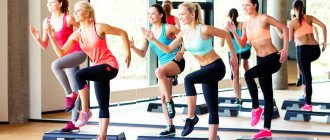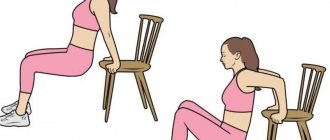Physical exercise is one of the principles of a healthy lifestyle. They are accustomed to them from a very young age. The mother does the first exercises for newborns together with the baby. Morning physical education helps the baby wake up, energizes him for the whole day, strengthens muscles and develops a sense of discipline. However, for gymnastics to really bring benefits and be a joy, you need to follow some rules.
Morning exercises - the main blocks of the lesson
Block No. 1 - Walking in a circle. Start of warm-up.
Morning exercises should begin with a short warm-up. Warming up promotes oxygen saturation and improves blood circulation, relaxes tight muscles and joints, and prepares children for more intense training.
- Start with easy walking in place or marching with your knees raised.
- Add alternating arm swings
- Continue your warm-up with dynamic stretches such as lunges and twists. Continue walking in a circle.
- Move at a moderate pace. Remind children to breathe normally
Block No. 2 - Aerobics
After warming up, do aerobic exercise to strengthen your cardiovascular system.
- Run in place for one minute, then jump for one minute (you can use a jump rope)
- Children's aerobic exercises: Climbers, Crab Walks, Knee Jumps
- You can use elements of steps from classical aerobics to music (for example V-step)
- Movement-based group games
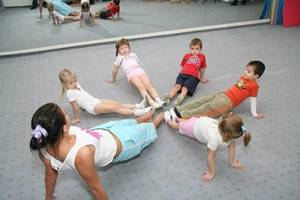
Movement-based group games
Movement-based group games are a great way to have fun and strengthen your cardiovascular and respiratory systems.
Block No. 3 - Strength exercises
Exercise helps increase strength and improves bone density.
- To develop arm strength, use light dumbbells or resistance bands.
- Squats and foot squats work the muscles of the buttocks and legs.
- Push-ups will develop arm strength and strengthen your chest.
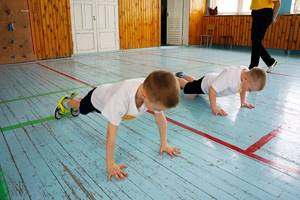
Classic push-ups are a great exercise for strengthening your arms and chest.
- Abdominal exercises will strengthen your abdominal muscles.
Block No. 4 - End of charging - stretching
Stretching is the best way to end a workout for both adults and children. Turn on calm, relaxing music. Encourage children to slow down their breathing.
- We reach our toes while standing or sitting.
- We arch and bend our back in the “Cat” exercise, stretching the spine.
- Cross your legs in a half-lotus position, stretching your leg muscles.
Invite children to raise their hands and take a deep breath and sharply lower their hands down as they exhale. Do this several times to release the tension.
To ensure that children enjoy their morning exercises, it is better to select videos for children based on their hobbies and interests. So, children who love music will certainly enjoy doing exercises accompanied by rhythmic melodies.
Most children love music, so exercises with musical accompaniment give them great pleasure, and unbeknownst to themselves, during the lesson, children develop a sense of rhythm and an ear for music. Therefore, it is to the music that morning exercises are carried out for children in kindergarten. But using the appropriate videos, you can organize equally complete classes at home.
At what age to start
Up to a year, mother and baby are engaged in what can be called preparation for real gymnastics: exercises for newborns up to a month include stroking and stretching, accompanied by poetry. They give the baby a positive experience from the contact between the mother and his own body.
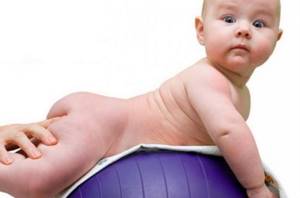
Then passive gymnastics is added to the general strengthening massage for infants: the mother carefully bends and unbends, brings and spreads the arms and legs of the baby. You can also practice with your baby on a fitball.
Important! Before doing infant gymnastics, consult your pediatrician and take a few lessons from a professional massage therapist.
Let's sum it up
Morning exercises have a beneficial effect on a growing body. It gives impetus to harmonious physical development. To ensure that gymnastics only brings benefits, consider the child’s age, health and desire. Turn it into a tradition, an entertaining game and do it regularly. Do not overtire your child, let gymnastics fulfill its main task: it helps the body wake up and gives a charge of vigor. Then you will gradually teach your son or daughter to exercise. In the future, this will help them quickly adapt to sports loads and fall in love with training.
Preparation
From the very beginning, gymnastic exercises will be somewhat difficult for children 10 years old. This is explained by the fact that children will have to get out of bed 20 minutes earlier, which at this age is often done with great difficulty. The child should be accustomed to this gradually, but in no case should he give up what he has planned just because the young gymnast is very lazy. After a couple of weeks of starting the morning like this, the children themselves reach out for exercise.
Both morning and evening exercises significantly improve your mood. If the child is too capricious, you can use a rug, a ball, or a stick with images of your favorite characters as auxiliary devices. You can find such equipment in any specialized store, and these products are not so expensive.
Warm-up
Warming up helps warm up the muscles and avoid subsequent pain. It is important to follow the correct order so that the load does not damage the children’s muscles and ligaments:
- start with fast walking;
- then load the arms, belt, back;
- the next part is strengthening the leg muscles;
- the active part includes running and jumping;
- finish with exercises to calm breathing: walking, inhaling and exhaling while raising your arms, etc.

When is the best time for a younger student to do exercises? How to prepare for gymnastics?
Man by nature must move a lot. It’s not for nothing that they say that movement is life. The less a child moves, spending all his free time near the TV, the more health problems he gets.
Children's specialists are sounding the alarm and reminding parents that children's bodies should be actively moving at least 10 hours a week, and for younger schoolchildren this minimum increases to 3 hours a day. Moreover, it is desirable that this happens in the fresh air.
Naturally, parents have too little time, but still dedicating 20 minutes in the morning and 20 minutes in the evening for exercise is not that difficult.
Examples of strength exercises
Show your child these simple exercises and get them interested in your example.
- Push ups. As you inhale, begin to slowly lower yourself down until your chest touches the floor. As you exhale, return to the starting position. Please note that your body should be a straight line when doing this.
- Hand raises. The exercise is performed with dumbbells. Choose the easiest ones. Take them, straighten up and lower your hands to your sides. As you inhale, begin to raise your arms up until your shoulders touch your ears. As you exhale, lower your arms down.
- Pull-ups. As you inhale, slowly begin to pull yourself up towards the bar until your chin touches it. As you exhale, lower yourself down.
Sports for children. Workouts for teenagers
Everyone knows that a sedentary lifestyle leads to various abnormalities. This has a particularly unfavorable effect on children: stunted growth, mental and physical retardation, decreased immunity. Physical education improves coordination and plasticity of movements, instills discipline skills and promotes further desire in special sections.
How to determine if a child is overweight?
Parents should monitor the health of their child. They can independently conclude that he has problems with his figure and begin to fight them. To do this, it is necessary to analyze his habits, diet and quality of nutrition, and physical activity.
Up to 3 years
Feeding infants should be carried out according to two main schemes: according to a schedule or on demand. The problem is that due to the developed sucking reflex, the baby often continues to suck on the breast or bottle even after he is full, which can cause the baby to become overweight. Symptoms of this condition:
- bowel dysfunction (constipation or diarrhea);
- weight exceeding the norm for age.
You can find the standards in the table:
| Age | Boys | Girls |
| Birth | 3,6 | 3,4 |
| 1 month | 4,45 | 4,15 |
| 2 months | 5,25 | 4,9 |
| 3 months | 6,05 | 5,5 |
| 4 months | 6,7 | 6,15 |
| 5 months | 7,3 | 6,65 |
| 6 months | 7,9 | 7,2 |
| 7 months | 8,4 | 7,7 |
| 8 months | 8,85 | 8,1 |
| 9 months | 9,25 | 8,5 |
| 10 months | 9,65 | 8,85 |
| 11 months | 10 | 9,2 |
| 1 year | 10,3 | 9,5 |
| 2 years | 12,67 | 12,05 |
| 3 years | 14,3 | 13,85 |
In infants, serious problems with excess weight practically do not arise.
Since children under one year of age are subject to mandatory monthly examination by a pediatrician, where one of the mandatory procedures is weighing, excess weight is almost always detected in a timely manner. The doctor will draw the parents’ attention to this and help adjust the baby’s diet.
From 3 to 10 years
According to statistics, the dangerous period when children become overweight is considered to be between the ages of 6-7 and 9 years. Symptoms that should alert parents:
- profuse sweating;
- shortness of breath after increased physical activity;
- the child’s changed figure: protruding belly, plump limbs, shoulders, rolls on the sides;
- child's complaints of headache caused by high blood pressure;
- child’s refusal to engage in physical activity;
- overweight.
Weight norms at this age are presented in the table:
Excess weight occurs due to poor diet and inactive lifestyle
From 10 years old
The most critical age is considered to be around 12-17 years. In addition to the above symptoms:
- puberty disorder;
- depression;
- joint pain;
- deviation of weight from the average value for age.
Weight standards for 10-17 years:
Leg-split
In conclusion, we should tell you how to teach a child to do the splits, because it is also the basis of gymnastics. Doing this is very useful, but only those with good stretching can do it. You can achieve this result with simple exercises:
- Standing near a chair, grab the back of it with your hand, bend one leg at a right angle and lift it to the side and back, feeling the tension in your thigh.
- Place your feet shoulder-width apart or slightly further apart, tilt your body and alternately reach your opposite toes with your hands.
- Sit on the floor, spread your straight legs to the sides as much as possible, stretch your arms forward so that you feel a stretch, and hold for 5-8 seconds.
- While in a sitting position, bend your legs, bring your feet together, moving them closer to you, spread your knees to the sides and vigorously work them, swinging up and down. Your back should remain straight and your hands should rest on your knees.
After a couple of weeks of regularly performing these exercises, you can try doing the splits. To do this, you will need to place one leg slightly in front of the other and, sliding or in different directions, lower yourself to the floor. The transverse split is performed in the same way, but in it the legs will have to be placed clearly to the sides.
Exercise for teenagers plays an important role in their lives. This is because it is during this period that the figure begins to form, as well as the character of the child, his attitude to the world and to himself. Therefore, there are a number of special exercises that will help a teenager form a beautiful and healthy body.
Recommendations
When working with children, you should take into account the underdevelopment of their bones and not use force against them.
You need to work with them with the most careful and smooth movements so as not to damage their health in any way.
Before you start doing strength exercises, it is recommended to warm up your muscles a little. You should start your classes with a set of exercises for the neck and finish with exercises for the legs.
All exercises are performed from top to bottom.
You should not do many approaches the first time to avoid muscle spasms.

Good habits are instilled from childhood, and therefore it is very important to help a child and serve as a good example from the very first day of his life.
Wheel
The well-known wheel exercise begins with a handstand. It can be done near a wall, which makes the task much easier. To do this, you need to secure the child by moving his legs to the support when they reach the top point. As soon as the young gymnast manages to stand up on his hands independently and hold on tightly for more than 30 seconds, he can begin to master the cartwheel technique. First of all, it is recommended to imagine its implementation in your head in order to understand how it looks visually.
Doing the wheel exercise against a wall is not that difficult. It is only important to follow the sequence of steps:
- In a handstand, spread your legs wider.
- Bend to the side and, raising the opposite arm, place your feet on the floor, turning your body over.
- Standing on your feet, bend to the side, place one palm on the floor, raise your legs in turn, while simultaneously resting your other hand on the floor.
- Combine all previous steps and perform the movement at a faster pace.
When the wheel comes out perfectly near the wall, you should start moving away from it. The fear of open space will pass quite quickly, so performing the exercise smoothly and beautifully will not be difficult.
What clubs and sections are there for girls and boys aged 11?
Where to send a child: a boy or a girl at 11 years old? Which clubs and sections are most suitable for children at this age? You need to know that different age groups of children have their own standards for physical activity. For 11-year-old schoolchildren, the norm is 20,000 steps per day, that is, children should move about 6 hours every day. Lack of mobility can lead to negative consequences: it poses a real threat to your child’s health. So which sport should you choose? Remember, it all depends on what your child wants, on his desires and aspirations. If you want to enroll him in a club just for general development, choose swimming, gymnastics, rock climbing, or kettlebell lifting. If your child is determined to achieve success in sports, you can sign him up for bobsleigh, biathlon, or powerlifting. You also need to focus on the child’s temperament, level of physical development, flexibility and reaction speed.
Remember that if you have any chronic diseases, you can sign up for a sports section only after consulting a doctor. Some sports aggravate the course of a particular disease. So, swimming can worsen sinusitis, and winter sports can worsen allergies to cold or asthma.
When choosing sports sections, be guided by the wishes of your child and common sense. Be sure to develop your child, and he will not have problems with mental and physical health.
Not only adults face the problem of excess weight. The number of overweight children is growing every year. This condition not only entails deterioration in health, but also has a negative impact on the fragile psyche of the child, who is forced to deal with criticism from peers.
If a child is overweight, it is important to competently approach the solution to this problem, and not let the situation take its course.
Exercises for gaining mass
A guy can have low self-esteem not only because of excess weight, but also because of its lack. After all, it is during adolescence that boys begin to worry about how the opposite sex perceives them. Therefore, it is not surprising that the young man strives to become strong.
Many parents make a mistake at such moments. They decide to send the teenager to do weightlifting or take him to the gym, where they try to force him to lift weights. This is the wrong approach, because the teenager’s skeleton is not yet adapted to such loads.
You should choose exercises as correctly as possible, as well as select the optimal frequency of exercises. It will be enough to train no more than three times a week. The duration of the training is about an hour.
Diet and nutrition for an overweight child
- fried foods: potatoes, cutlets, scrambled eggs in butter (see also:);
- semi-finished products: sausages, frankfurters;
- fast food;
- fatty sauces: mayonnaise, ketchup, etc.;
- sweets with questionable composition, purchased in stores;
- sweet carbonated drinks;
- foods high in simple carbohydrates: white bread, pies, pastries, pasta.
A child’s daily diet should include a variety of vegetables and fruits.
At the same time, the child’s diet should be varied and include:
- steamed dishes in the oven;
- lean meats and always red fish;
- salad dressings based on low-fat natural yogurt and olive oil;
- natural and healthy sweets: nuts, honey, dried fruits, dark chocolate with a high cocoa content;
- sufficient amounts of fruits and vegetables daily.
Such a diet should be perceived by the child not as a temporary restriction followed by a return to favorite foods, but as a nutritional culture that needs to be instilled gradually. Parents, by example, should force him to lose weight. To achieve this, not only the person suffering from excess weight is required to eat appropriately, but also the entire family, which will also benefit from it.
Not only the set of products is important, but also the diet, as well as the amount of food eaten at a time. The best option is 5 meals a day, consisting of lunch, breakfast, dinner and two light snacks. The main consumption of carbohydrates should be moved to the first half of the day so that the body has time to process them, and dinner should be a light meat dish with vegetables.
Fruits, dairy products and nuts are great snacks. If your child is hungry before bedtime, offer him a glass of kefir or an apple.



